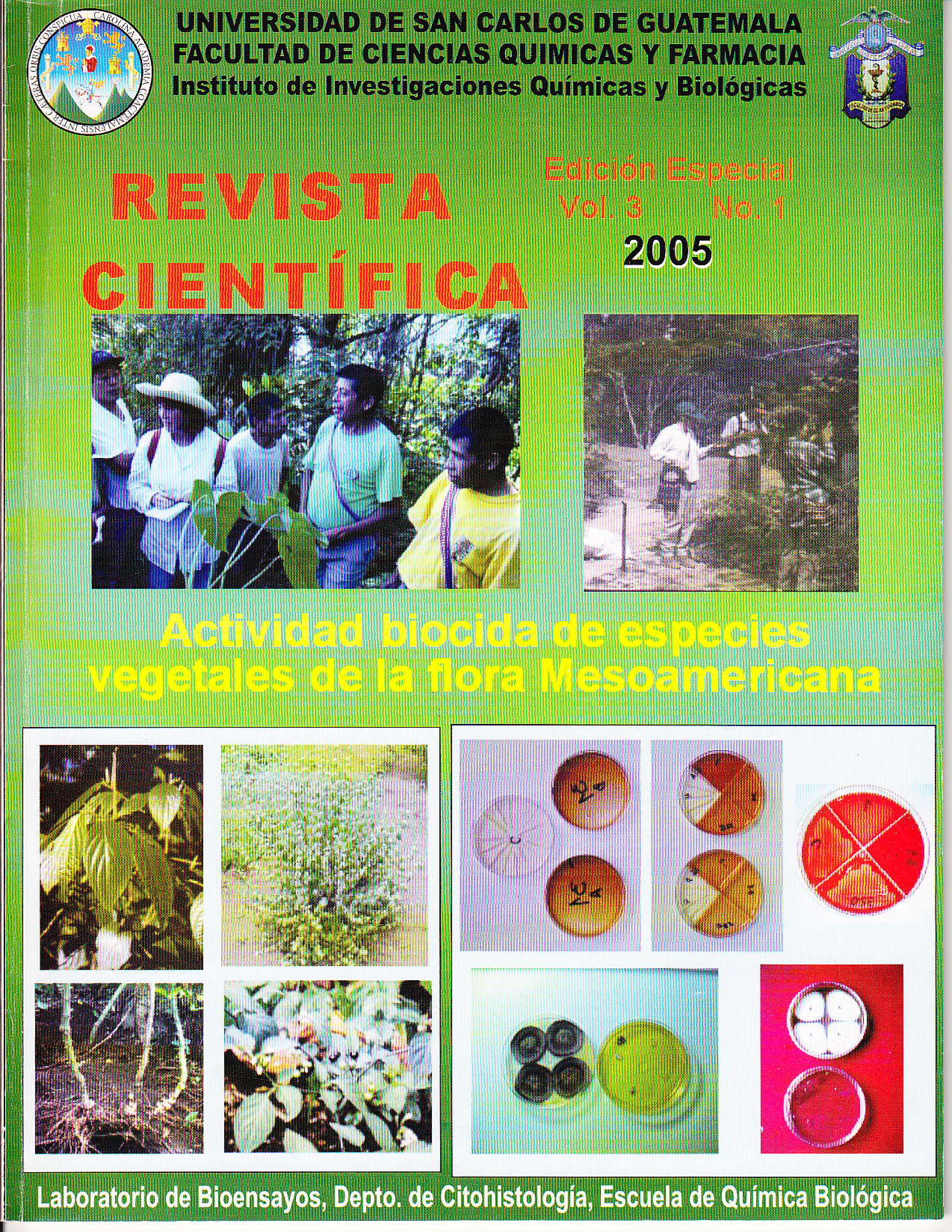Biocidal Activity Of Six Medicinal Plants In The Municipality Of Tacaná, San Marcos, Guatemala
DOI:
https://doi.org/10.54495/Rev.Cientifica.EdicionEspecial2005.195Keywords:
Biocidal activity, Plants for medicinal use, Tacana MunicipalityAbstract
In the municipality of Tacaná, San Marcos, Cardona began a thesis in 2001, collecting ethnobotanical information from the Mam community. The results of this work were proposed as a recommendation for the scientific validation of the therapeutic action attributed to plants, especially those for which there is little or no bibliographic information. Six species were selected and obtained: Bocconia arborea, Hypericum idiginosum, Prionosciadium lhapsoides, Salvia lavanduloides, Salvia microphylla, and Selaginella silvestris. The 95% ethanol-related components of each were extracted by repercolation. The ethanolic extracts were tested against Gram-positive and Gram-negative bacteria, yeasts, filamentous fungi, protozoa, insect larvae, and the nauplius Anemia salina (Salt Anemia), to determine their biocidal activity. In the antibacterial and antiyeast assay, H. idiginosum activity was demonstrated at a minimum inhibitory concentration (MIC) of 0.25 mg/mL for Staphylococcus aureus, Bacillus subtilis, Mycobacterium smegmatis and Cryptococcus neoformans, and at an MIC of 1 mg/mL for Trichophyton rubrum', S. microphvlla had activity at an MIC of 0.25 mg/mL for C. neoformans, 0.5 mg/mL for S. atireus, B. subtilis, M. smegmatis, and 1 mg/mL for I rubrum', of B. arbórea an MIC of 0.5 mg/mL sc found activity against S. aureus and M. smegmatis; of P. lhapsoides at an MIC of 0.5 mg/mL for M. smegmatis and T. rubrum at an MIC of 1 mg/mL; 5', lavanduloides for 5. aureus, B. subtilis, M. smegmatis, C. neoformans at an MIC of 1 mg/mL. No activity was found in S. silvestris. In the activity against protozoa, a biocidal effect was found in B. arbórea, inhibiting 90% of the protozoa at the following concentrations: 0.38 mg/mL for Trypanosoma cruzi, 0.46 mg/mL for Leishmania braziliensis and 0.82 mg/mL for Leishmania mexicana. The ethanolic extract of P. lhapsoides seeds inhibited the Leishmania genus at a concentration of 0.66 mg/mL and 0.79 mg/mL for L. braziliensis and L. mexicana, respectively. Neither extract showed cytotoxic activity against A. salina, nor insecticidal activity against Aedes nfgypft and Anopheles albimanus larvae in any of their four larval stages.
Downloads
References
Cardona A. Etnobotánica de Flora Nativa de Uso Medicinal y Alimenticio en una Población de Etnia mam del Municipio de Tacana, San Marcos. Guatemala: Universidad de San Carlos. Centro Universitario de Occidente, (protocolo de tesis de graduación, Facultad de Agronomía) 2001. 36p.
Ralda H. Plantas de uso popular utilizadas con fines medicinales en el área Mam del departamento de Huehuetenango: Estudio realizado en los Municipios de Malacatancito, San Gaspar Ixchil, San Sebastián, Huehuetenango y Santa Bárbara del departamento de Huehuetenango en el período comprendido de 1 de abril al 31 dejuliode 1989. Guatemala: Universidad de San Carlos, (tesis de graduación, Facultad de Ciencias Médicas) 1989. 131p.
Fernández H. Etnobotánica de los recursos fitogcncticos de uso medicinal presentes en 8 municipios del área de influencia étnica Mam, del departamento de Huehuetenango. Guatemala: Universidad de San Carlos, (tesis de graduación, Facultad de Agronomía) 1992. 275p.
Aguilar R. Estudio etnobotánica de especies nativas de valor medicinal y su uso actual en las comunidades de etnia Mam. Tajumulco. San Marcos. Guatemala: Universidad de San Carlos: Centro Universitario de Occidente, (tesis de graduación, Facultad de Agronomía) 1998. 134p.
Programa Iberoamericano de Ciencia y Tecnología para el Desarrollo (CYTED). Manual de Técnicas de Investigación. Bogotá: Proyecto X-1 Doc. Tec. 1993. S/n.
Mitscher L. el al. .Antimicrobial agents from higher plants. 1. Introducción rationale and methodology. Lloydia. 1972;35:157-166.
Mac Rae W.. et. al. Studies on the pharmacological activity of Amazonian Euphorbiaceae. J. Etnopharmacol. 1988; 22: 143-172, https://doi.org/10.1016/0378-8741(88)90124-9
González. J. et al. In vitro activity of natural products against the tripomastigote form of Trypanosoma cruzi. Phytother. Res, 1990;4:1-4, https://doi.org/10.1002/ptr.2650040102
Finney D. Probit Analysis. 3a edición. USA: Cambridge University Press 1971. 333p.
Michael .A.et al. Artemia salina as a test organism bioassay. Sci. 1956:123:456, https://doi.org/10.1126/science.123.3194.464-a
Spiegel MR. Estadística. 2a edición. México: Editorial McGraw-Hill. 1991. 356p. (p.159-163).
Pelczar M. el al. Microbiología. 4;l edición. México: Editorial McGraw-Hill, 1982. XIV+826p. (p.60).
Navarro V. el al. Antimicrobial evaluation of some plants used in Mexican traditional medicine for the treatment of infectious disease. J. Ethnophrmacol. 1996:53 3:143-147. https://doi.org/10.1016/0378-8741(96)01429-8
Navarro V. et al. Antimicrobial compounds detected in Bocconia arbórea extracts by a direct bioautographic method. Arch. Med. Res. 1998;29 2:191-194, https://doi.org/10.1016/0378-8741(96)01429-8
Instituto Nacional Indigenista. Atlas de las Plantas de la Medicina Tradicional Mexicana. México: Biblioteca de la Medicina Tradicional Mexicana. 1994. Vols. Ill, Vol. I y II. 1786p (p.l 16, 19,1009-1010).
Taylor HL, Broker RM. The isolation of uligínosin A and uhginosin B from Hypericum uliginosum Lloydia, 1969:32 2:217-219. https://doi.org/10.1080/00304946909458384
Downloads
Published
How to Cite
Issue
Section
License
Copyright (c) 2005 Lorde Lorenzana, Antulio Neliemías, Cardona Fuentes, Armando Cáceres

This work is licensed under a Creative Commons Attribution 4.0 International License.
Authors who publish with this journal agree to the following terms:
- Authors retain copyright and grant the journal right of first publication with the work simultaneously licensed under a Creative Commons Attribution License 4.0 that allows others to share the work with an acknowledgement of the work's authorship and initial publication in this journal.
- Authors are able to enter into separate, additional contractual arrangements for the non-exclusive distribution of the journal's published version of the work (e.g., post it to an institutional repository or publish it in a book), with an acknowledgement of its initial publication in this journal.
- Authors are permitted and encouraged to post their work online (e.g., in institutional repositories or on their website) prior to and during the submission process, as it can lead to productive exchanges, as well as earlier and greater citation of published work.









